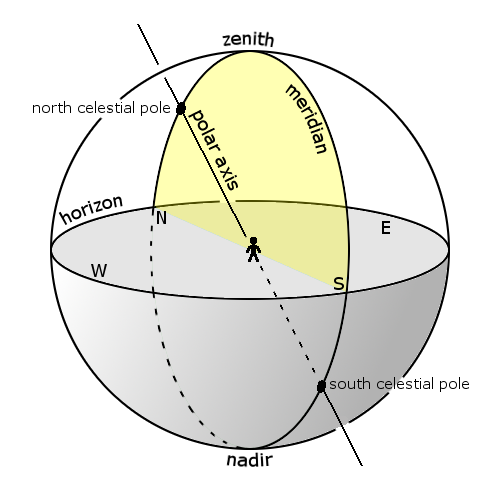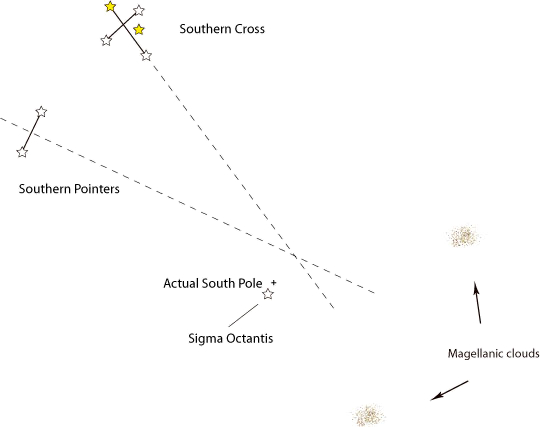Tonight, we’re paying tribute to the Southern Cross, also known as the constellation Crux, for our friends in the Southern Hemisphere. No matter where you live in the Southern Hemisphere, look in your southern sky for the Southern Cross as soon as darkness falls.
At temperate latitudes in the Southern Hemisphere, where it’s now the winter season, we astronomers say the Southern Cross swings to upper meridian transit – its high point in the sky – at early evening, or roughly 7 p.m. local time.
Image top of post is the Southern Cross as seen from Manila – latitude 14 degrees N. of the equator – in 2012. The photo is from EarthSky Facebook friend Jv Noriega. View it larger.

The meridian is the imaginary semi-circle that divides your sky into its eastern and western hemispheres. A star reaches it highest point when it crosses the meridian at upper transit, and its lowest point when it crosses the meridian at lower transit.
Because the Southern Cross is circumpolar – always above the horizon – at all places south of 35o south latitude, people at mid-southern latitudes can count on seeing the Southern Cross all night long, every night of the year. Watch for the Southern Cross to move like a great big hour hand, circling around the south celestial pole in a clockwise direction throughout the night. The Southern Cross will sweep to lower meridian transit – its low point in the sky – around 7 a.m. local time tomorrow.

Star-hopping to south celestial pole via the Southern Cross and the bright stars Alpha Centauri and Hadar.
If the Southern Cross is circumpolar in your sky, then the Big Dipper never climbs above your horizon.
Conversely, if the Big Dipper is circumpolar in your sky, then the Southern Cross never climbs above your horizon. Additionally, the W or M-shaped constellation Cassiopeia is also circumpolar at northerly latitudes. See the animation below.
However, if you live in the tropics, there are times when you can actually see the Big Dipper and the Southern Cross in the same sky together. In early June, for instance, the Southern Cross and Big Dipper reach upper transit – their high point – at virtually the same time, or around 7 p.m. local time.
You have a better chance of seeing the Southern Cross and the Big Dipper in the same sky right now from the southern tropics. That’s because the winter season in the Southern Hemisphere ushers in an earlier sunset time than at comparable latitudes in the northern tropics, where it is now summer.
The Big Dipper and the W-shaped constellation Cassiopeia circle around Polaris, the North Star, in a period of 23 hours and 56 minutes. The Big Dipper is circumpolar at 41o N. latitude, and all latitudes farther north.
Bottom line: A tribute to the Southern Cross, also known as the constellation Crux.
from EarthSky https://ift.tt/28PkOW0
Tonight, we’re paying tribute to the Southern Cross, also known as the constellation Crux, for our friends in the Southern Hemisphere. No matter where you live in the Southern Hemisphere, look in your southern sky for the Southern Cross as soon as darkness falls.
At temperate latitudes in the Southern Hemisphere, where it’s now the winter season, we astronomers say the Southern Cross swings to upper meridian transit – its high point in the sky – at early evening, or roughly 7 p.m. local time.
Image top of post is the Southern Cross as seen from Manila – latitude 14 degrees N. of the equator – in 2012. The photo is from EarthSky Facebook friend Jv Noriega. View it larger.

The meridian is the imaginary semi-circle that divides your sky into its eastern and western hemispheres. A star reaches it highest point when it crosses the meridian at upper transit, and its lowest point when it crosses the meridian at lower transit.
Because the Southern Cross is circumpolar – always above the horizon – at all places south of 35o south latitude, people at mid-southern latitudes can count on seeing the Southern Cross all night long, every night of the year. Watch for the Southern Cross to move like a great big hour hand, circling around the south celestial pole in a clockwise direction throughout the night. The Southern Cross will sweep to lower meridian transit – its low point in the sky – around 7 a.m. local time tomorrow.

Star-hopping to south celestial pole via the Southern Cross and the bright stars Alpha Centauri and Hadar.
If the Southern Cross is circumpolar in your sky, then the Big Dipper never climbs above your horizon.
Conversely, if the Big Dipper is circumpolar in your sky, then the Southern Cross never climbs above your horizon. Additionally, the W or M-shaped constellation Cassiopeia is also circumpolar at northerly latitudes. See the animation below.
However, if you live in the tropics, there are times when you can actually see the Big Dipper and the Southern Cross in the same sky together. In early June, for instance, the Southern Cross and Big Dipper reach upper transit – their high point – at virtually the same time, or around 7 p.m. local time.
You have a better chance of seeing the Southern Cross and the Big Dipper in the same sky right now from the southern tropics. That’s because the winter season in the Southern Hemisphere ushers in an earlier sunset time than at comparable latitudes in the northern tropics, where it is now summer.
The Big Dipper and the W-shaped constellation Cassiopeia circle around Polaris, the North Star, in a period of 23 hours and 56 minutes. The Big Dipper is circumpolar at 41o N. latitude, and all latitudes farther north.
Bottom line: A tribute to the Southern Cross, also known as the constellation Crux.
from EarthSky https://ift.tt/28PkOW0

Aucun commentaire:
Enregistrer un commentaire